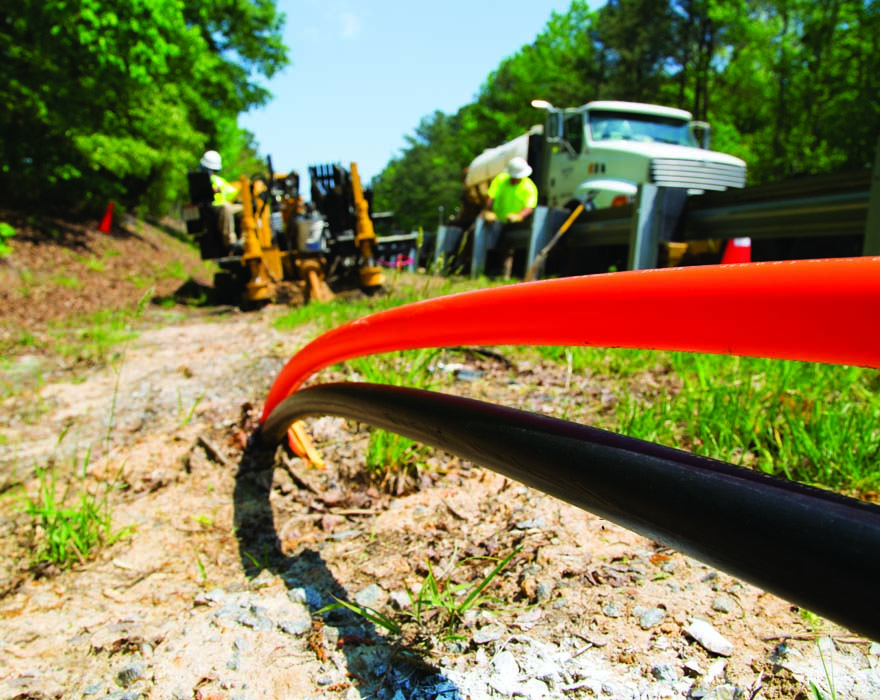It’s getting crowded out there! From small fiberoptics and cable TV lines to larger water, gas and wastewater pipelines, there’s a significant amount of buried infrastructure to avoid while installing underground utilities. Those busy underground rights of way make diligent bore planning more important than ever to help prevent utility strikes.
Bore planning steps
According to Kipp Ulferts, applications specialist for Vermeer Intelligent Worksite Solutions, for many smaller diameter installs at short distances, bore planning may involve calling in locates, daylighting all existing utilities, walking the bore path, and then creating a bore plan. However, for larger projects at greater distances and in areas where there are several utilities nearby, he recommends incorporating planning tools like Vermeer Projects software.
“Planning needs to start with mapping out a bore path or white lining that includes target depths and accounts for product bend
tolerances. This information will help a contractor determine and negotiate entrance and exit points,” Ulferts said.
The next step is to call in locates, followed by visual verification of all the utilities along the bore path. Ulferts recommends adding the GPS coordinates and depths of all of the services to the pre-bore plan. “Larger jobs take longer, and there are usually a lot of considerations involved, so it’s important to have documentation that notes everything that’s in the
ground.”
After existing utilities are noted, the bore path should be reviewed and revised to help verify there is proper clearance between the product being installed and what’s already in the ground. “When looking at the distance of allowable space between utilities, contractors have to make sure they’ve given themselves enough space for reaming. In many soil conditions, the weight of the reamer can cause the depth of the bore hole to drop a bit.”
Once everything is adjusted, it’s time to share the bore plan with all the responsible parties on the job, including the crew that will be working the project. The bore plan developed will be their roadmap for the install.
During the bore
Planning doesn’t stop when the work starts, though. To help avoid utility strikes, crew members need to be paying attention to the bore plan closely during the bore and keep track of bore depths. Tracking depths manually with a logbook is one way of doing it. However, crews using Vermeer Projects and a supported DCI® DigiTrak Falcon™ receiver can keep track of it all through an onboard DigiTrak® Aurora®display with Vermeer BoreAssist. From the operator seat, bore plans can be viewed and adjusted right from the display. Also, with DCI Log-While-Drilling (LWD™) Live, the crew can compare real-time drill head tracking with the bore plan.
Ulferts also recommends noting the location of landmarks around the area at the time of the bore to help with locating buried utilities in the future. “Over time, things above ground can change dramatically, but what’s underground remains unchanged. However, capturing the distance between a landmark that is unlikely to change in the near future and the utility can help someone find it in the future,” he explained.
Documenting it all
Planning is not done yet. After the bore is completed, it’s time to compare and update the bore plan with as-built information. “Many utility companies require contractors to provide as-built bore profiles because it will help with future expansions or replacements,” said Ulferts. “As-built information will also help another contractor out as he or she is planning to install product in the same area. Detailed documentation now can help reduce the number of utility strikes in the future.”
Easing the process
Planning before, during and after a project is complete is vital to helping avoid utility strikes. The process outlined above doesn’t have to be labor-intensive, though. Vermeer Projects makes it convenient to create a bore plan, capture GPS coordinates of existing utilities, as well as add depths and calculate allowable space between services. Reports from Vermeer Projects are also convenient to share.
On the drill, operators can select the model they are running and follow the rod-by-rod directions from an onboard display.
Meanwhile, the locator’s marked points throughout the bore can be quickly uploaded to the Vermeer Projects cloud.
Afterward, pre-bore and as-built data can be merged with all other relevant bore details, including noted landmark photos. It will be stored within the system and can also be shared with others.
To get started with Vermeer Projects, contact your local Vermeer dealer.
Vermeer Corporation reserves the right to make changes in engineering, design and specifications; add improvements; or discontinue manufacturing at any time without notice or obligation. Equipment shown is for illustrative purposes only and may display optional accessories or components specific to their global region. Please contact your local Vermeer dealer for more information on machine specifications. Vermeer and the Vermeer logo are trademarks of Vermeer Manufacturing Company in the U.S. and/or other countries. DCI, DigiTrak, Aurora and LWD are trademarks of Digital Control Incorporated.
© 2019 Vermeer Corporation. All Rights Reserved.
